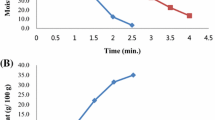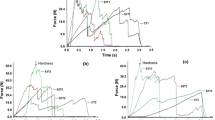Abstract
The aim of this work was to provide a thorough evaluation of quality characteristics of French fries prepared from frozen potatoes using different home-cooking systems. French fries were prepared using deep-fat fryer, air-frying appliances, convection oven, and microwave oven. Two commercial frozen potato sticks, specifically intended for deep-fat frying and for oven cooking, respectively, were used for the cooking tests. The obtained French fries were analyzed for compositional parameters and for sensory properties by instrumental analyses (texture, color, and aroma) and descriptive analysis. Significant differences in physico-chemical and nutritional characteristics of the final products were observed, depending on both the raw material and the cooking system; analytical data were in good agreement with the sensory results. French fries obtained by oven cooking of apposite frozen potato sticks had sensory characteristics similar to those of deep-fat fried potatoes, with low acrylamide (about 50 µg/kg) and lower fat content (7.4–11.1 g/100 g compared to 14.5–17.1 g/100 g in deep-fat fried potatoes); on the other hand, oven cooking was the most expensive system in terms of energy consumption. Quality characteristics of French fries obtained by air-frying and microwave cooking were poorer, and these products had higher acrylamide content (up to 410 µg/kg in microwave cooked samples).




Similar content being viewed by others
References
Saguy S, Dana D (2003) Integrated approach to deep fat frying: engineering, nutrition, health and consumer aspects. J Food Eng 56:143–152
Erdogu SB, Palazoglu TK, Gokmen V, Sanyuva HZ, Ekiz HI (2007) Reduction of acrylamide formation in French fries by microwave pre-cooking of potato strips. J Sci Food Agric 87:133–137
EFSA (2012) Update on acrylamide levels in food from monitoring years 2007 to 2010. EFSA J 10:2938–2976
Williams JSE (2005) Influence of variety and processing conditions on acrylamide levels in fried potato crisps. Food Chem 90:875–881
Kumar D, Singh BP, Kumar P (2004) An overview of the factors affecting sugar contents of potaotes. Ann Appl Biol 145:247–256
Haiqing Y, Yutian M, Chengcheng Z, Yuan Y (2011) Acrylamine and methylglyoxal formation in potato chips by microwaving and frying heating. Int J Food Sci Technol 46:1921–1926
Hogervorst JG, Schouten LJ, Konings EJ, Goldbohm RA, van den Brandt PA (2007) A prospective study of dietary acrylamide intake and the risk of endometrial, ovarian, and breast cancer. Cancer Epid Biol Prev 16:2304–2313
Hogervorst JG, Schouten LJ, Konings EJ, Goldbohm RA, van den Brandt PA (2008) Dietary acrylamide intake and the risk of renal cell, bladder, and prostate cancer. Am J Clin Nutr 87:1428–1438
Pedreschi F, Mariotti MS, Granby K (2014) Current issues in dietary acrylamide: formation, mitigation and risk assessment. J Sci Food Agric 94:9–20
Foot RJ, Haase NU, Grob K, Gonde P (2007) Acrylamide in fried and roasted potato products: A review on progress in mitigation. Food Addit Contam 24 (iss. sup 1):37–46
Sayon-Orea C, Bes-Rastrollo M, Basterra-Gortari FJ, Beunza JJ, Guallar-Castillon P, De la Fuente-Arrillaga C, Martinez-Gonzales MA (2013) Consumption of fried foods and weight gain in a Mediterranean cohort: the SUN project. Nutr Metab Cardiovasc Dis 23:144–150
Andres A, Arguelles A, Castello ML, Heredia A (2013) Mass transfer and volume changes in French fries during air frying. Food Bioprocess Technol 6:1917–1924
Del Rocio Teruel M, Gordon M, Linares MB, Garrido MD, Ahromrit A, Keshavan N (2015) A comparative study of the characteristics of French fries produced by deep fat frying and air frying. J Food Sci 80:E349–E358
Pedreschi F, Moyano P (2005) Oil uptake and texture development in fried potato slices. J Food Eng 70:557–563
PalazogluTK, Savran D, Gokmen V (2010) Effect of cooking method (baking comparted with frying) on acrylamide level of potato chips. J Food Sci 75:E25–E29
Chatterjee D, Bhattacharjee P, Bhattacharyya N (2014) Development of methodology for assessment of shelf-life of fried potato wedges using electronic noses: Sensor screening by fuzzy logic analysis. J Food Engin 133:23–29
Savarese M, Parisini C, De Marco E, Battiamo I, Falco S, Sacchi R (2007) Application of electronic nose to monitor the frying process. A preliminary study. Riv Ital Sostanze Gr 84:33–39
AOAC (1975) Official methods of analysis of the association of official analytical chemists, 12th edn. Washington DC
Naes T, Brockhoff B, Tomic O (2010) Statistics for sensory and consumer science. Wiley, Chichester
Gamble MH, Rice P, Selman JD (1988) Relationship between oil uptake and moisture loss during frying of potato slices from cv Record UK tubers. Int J Food Sci Technol 22:233–241
Mallikarjunan PK, Ngadi MO, Chinnan MS (2010) Breaded fried foods. CRC Press, Boca Raton
Saguy IS, Pintus EJ (1995) Oil uptake during deep-fat frying: factors and mechanism. Food Technol 49:142–145
Greenfield H, Makinson J, Wills RBH (1984) Lipids in French fries: a retail and laboratory study. J Food Technol 19:239–245
EFSA (2015) Scientific opinion on acrylamide in Food. EFSA J 13(6):4104. https://www.efsa.europa.eu/it/efsajournal/pub/4104
Ye HQ, Miao YT, Zhao CC, Yuan Y (2011) Acrylamide and methylglyoxal formation in potato chips by microwaving and frying heating. Int Food Sci Tech 46:1921–1926
EU, Information on ways to lower the levels of acrylamide formed in food. Acrylamide workshop, 20–21 October 2004 http://ec.europa.eu/food/safety/docs/cs_contaminants_catalogue_acrylamide_guidance_en.pdf
Author information
Authors and Affiliations
Corresponding author
Ethics declarations
Conflict of interest
The authors declare no conflict of interest.
Compliance with ethics requirements
This article does not contain any studies with human or living animal subjects.
Rights and permissions
About this article
Cite this article
Giovanelli, G., Torri, L., Sinelli, N. et al. Comparative study of physico-chemical and sensory characteristics of French fries prepared from frozen potatoes using different cooking systems. Eur Food Res Technol 243, 1619–1631 (2017). https://doi.org/10.1007/s00217-017-2870-x
Received:
Revised:
Accepted:
Published:
Issue Date:
DOI: https://doi.org/10.1007/s00217-017-2870-x




